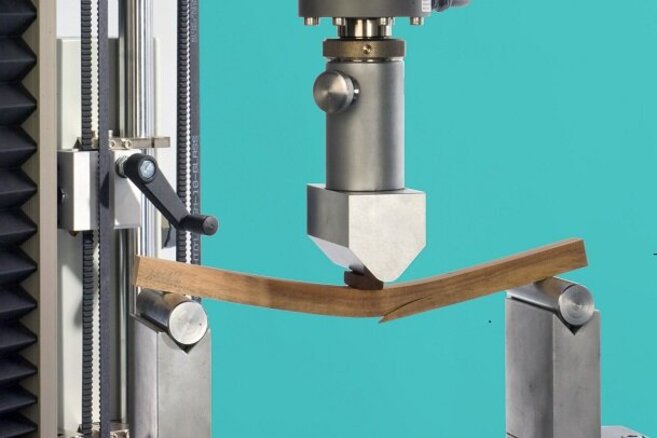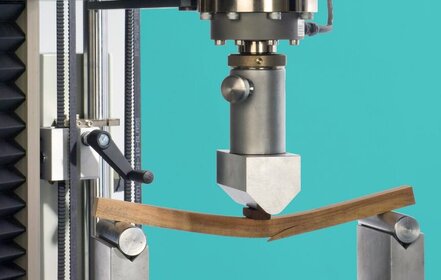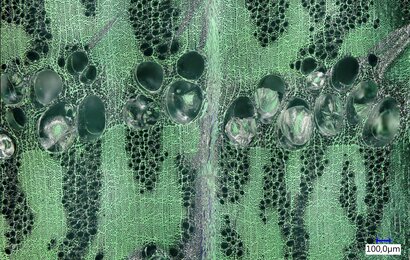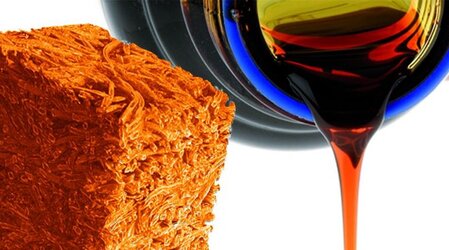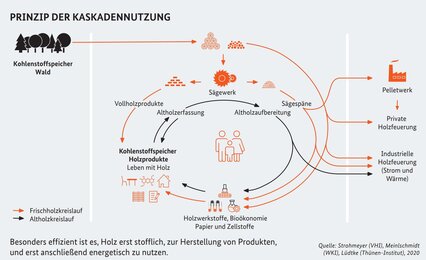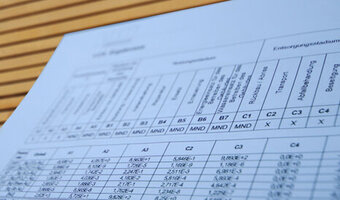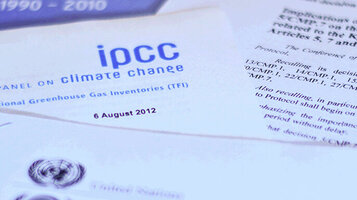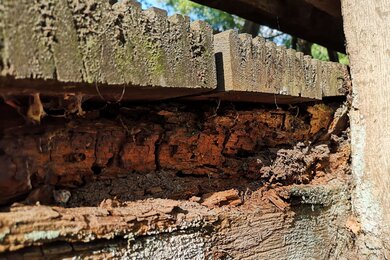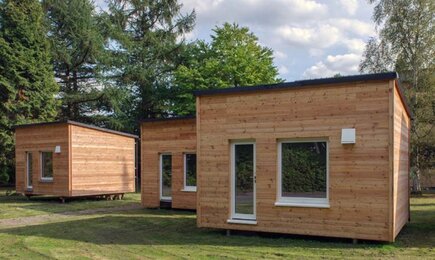Sustainable material use of wood
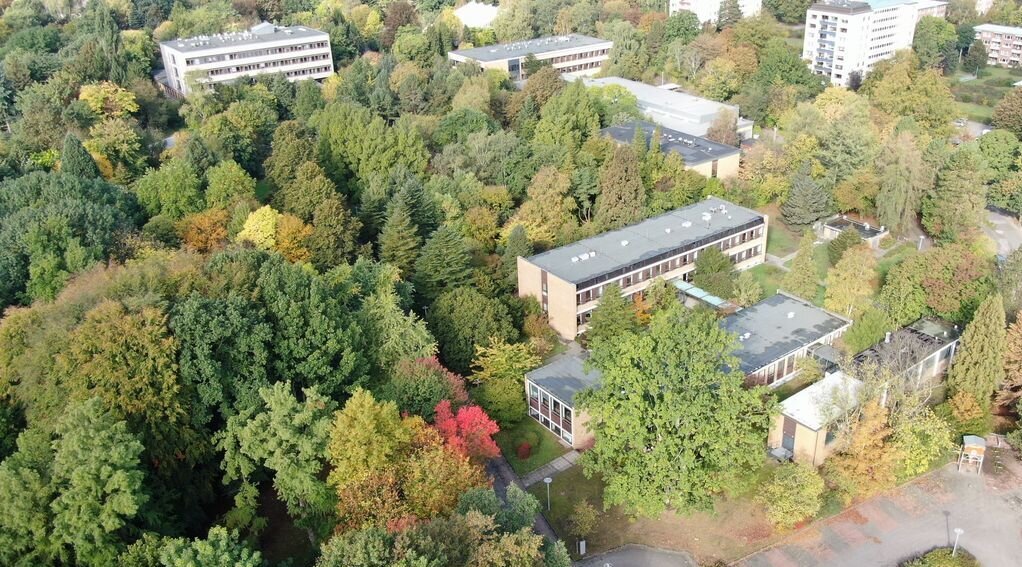
The efficient material use of wood from sustainable forestry makes an important contribution to climate protection. However, deforestation and overexploitation can also cause major damage to nature and the climate. The Thünen Institute for Wood Research is working on solutions that contribute to the sustainable, resource-efficient, safe and innovative use of wood.
The aim of our research into the material usability of wood and other lignocelluloses and their long-term fate in the material cycle is to optimize the climate impact of wood use, protect endangered wood species and forests, and improve the social benefits of the sector. Consumers should be assured that wood products do not pose a health risk. The properties of wood and wood-based materials are analyzed experimentally, new conversion processes are researched in the laboratory and pilot plant and implemented practically. Climate-relevant data are collected and modeled for the whole of Germany.
The optimisation of the material usability of wood begins with the analysis of the basic material properties.
We investigate these on wood and other wood-based materials (e.g. wood-based materials, paper, etc.). For this purpose, we determine the type of wood and the composition of the cell structure using microscopic and spectroscopic methods. The natural resistance of wood to biotic pests shows a very high variability. Therefore, we investigate the resistance to fungi, bacteria, insects and marine organisms. Physical properties, density, interaction with moisture, swelling and shrinkage and their effects on mechanical properties are analysed as well as the chemical composition and special characteristics of individual components and ingredients. Since wood properties change in many ways from the growth phase through processing and use to the end of the material use phase, they are examined at different stages of the life cycle. We are constantly improving and developing these analysis methods.
One focus of this work is the identification of wood species in products and raw materials within the framework of the European Timber Trade Regulation (EUTR). To control the international timber trade and to protect rare and endangered species (CITES), we identify wood species in many products, including paper, wood-based materials or charcoal. In this way, we support authorities in implementing the guidelines to limit illegal timber use. In order to meet this international challenge, we help other countries and institutions to establish their own control options through targeted training and further education of experts. A current focus is South America (Colombia).
Efficient and high-quality material use of wood is a challenge, especially for low-value raw material grades. Therefore, we are developing processes that focus on the use of such critical assortments. The aim of our research is to enable higher-value use and to generate opportunities for substituting non-renewable products with the wood-containing starting raw materials. Many conversion processes in wood processing lead to desirable main and undesirable by-product streams. This applies, for example, to cellulose production, in which lignin is produced in large quantities and can usually only be incinerated. With lignin as a basis, we are researching the production of adhesives (substitutes for phenol-based systems) and foams (substitutes for isocyanate-based systems). Other biorefinery processes also lead to poorly utilisable by-products, for which we are developing processes to obtain valuable platform chemicals (processing of biogenic pyrolysis oils into refinable intermediates). Low-value assortments, e.g. calamity wood, some hardwoods and residues such as bark, are being investigated for value-adding processes.
Often, the use of wood takes place on a linear path that leads from the forest via a single-stage material use to energy use. It would be better to use the wood as a material in the longer term; this can reduce the need for new raw materials and keep the carbon in the material cycle for longer. We are investigating and developing such recycling options and processes to improve the circular economy of wood. These include the improved use of waste wood in wood-based materials, optimised particle geometry through 3D measurement, but also the more frequent reusability of waste paper by adding reinforcing fibres made of straw.
The efficiency of wood products depends to a large extent on how much energy and other substances are needed for production, use and disposal. In order to minimise this use of resources and reduce negative environmental impacts, we prepare standard-compliant life cycle assessments for many products made of wood in cooperation with the manufacturers and associations of the wood industry.
The aggregated data are fed into public databases (e.g. www.oekobaudat.de) and are thus available to society as a basis for decision-making. We use these data to assess the environmental and climate impacts of wood use, which we model for all of Germany, for example, according to the specifications of the Intergovernmental Panel on Climate Change (IPCC) and report under the Framework Convention on Climate Change and the Kyoto Protocol. Modelling can also be used to show future scenarios that are relevant for the further development of the sector.
The extent to which a longer service life of wood products increases efficiency and helps to reduce negative environmental impacts per unit of time depends on the additional effort required to increase the service life. We are investigating the resistance of natural wood and wood products (picture wood damage possibly ask Lauritz Schrader) that have been treated (wood preservatives, modified wood) to increase resistance to biotic and abiotic damage influences of varying intensity. We investigate damage to structures caused by moisture and biological harmful organisms and develop methods to combat them.
The processing and use of wood is accompanied by the occurrence of various emissions. These emissions include the wood's own constituents (e.g. fresh wood odour) and the degradation products of wood components resulting from treatment and use. Another source of emissions from the products are the external additives (glue, varnish, etc.) used in the manufacturing process. Some of these substances can have negative health effects (e.g. formaldehyde). We investigate the emission behaviour of these volatile organic compounds (VOC) in practical experiments. For example, we want to better understand the psychological effect of these substances through context-based perception (pleasant or unpleasant odour). From these data, the effects on indoor air quality are to be worked out so that undesirable effects can be avoided or minimised.

The development of common goals and visions for the future of the forestry and wood sector is being further advanced by the stakeholders and politicians within the framework of the Charter for Wood 2.0. In addition to intensive cooperation in the working and steering committees, our special task is the process evaluation and documentation of the development of the Forestry and Wood Cluster. In this context, it is indispensable to agree on comparable procedures and evaluation bases. We actively promote this process in the area of standardisation. We support the development, improvement and comprehensive application of relevant standards, e.g. for testing biological durability and wood protection, emission behaviour and environmental impacts, with our technical expertise.

